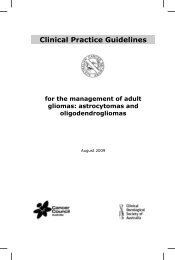Clinical Practice Guidelines for the management of locally advanced ...
Clinical Practice Guidelines for the management of locally advanced ...
Clinical Practice Guidelines for the management of locally advanced ...
Create successful ePaper yourself
Turn your PDF publications into a flip-book with our unique Google optimized e-Paper software.
1 INTRODUCTION<br />
1.1 Natural history and staging <strong>of</strong> prostate cancer<br />
Prostate cancer has many uncertainties associated with its <strong>management</strong>. A major problem <strong>for</strong> any<br />
review at present arises from <strong>the</strong> difficulty in establishing with certainty that <strong>the</strong> cancer is confined to<br />
<strong>the</strong> prostate at <strong>the</strong> time <strong>of</strong> diagnosis.<br />
Currently, through a combination <strong>of</strong> PSA measurement and ultra-sound-guided biopsy, it is now<br />
possible to establish with greater certainty than be<strong>for</strong>e <strong>the</strong> local extent <strong>of</strong> <strong>the</strong> cancer within <strong>the</strong> gland<br />
and its likely aggressiveness by application <strong>of</strong> <strong>the</strong> Gleason scoring system. This in<strong>for</strong>mation, when<br />
incorporated with o<strong>the</strong>r measurable factors into nomograms, has enabled clinicians to establish <strong>the</strong><br />
probability but not <strong>the</strong> certainty <strong>of</strong> <strong>the</strong> cancer being confined to <strong>the</strong> prostate.<br />
Be<strong>for</strong>e <strong>the</strong> introduction <strong>of</strong> PSA it was easier to be certain that a person had metastatic disease on <strong>the</strong><br />
basis <strong>of</strong> a positive bone scan or computed tomography (CT). Un<strong>for</strong>tunately, while <strong>the</strong> bone scan has a<br />
high level <strong>of</strong> specificity its sensitivity is too low and in current prostate cancer <strong>management</strong>, bone<br />
scans have little use in determining <strong>the</strong> presence <strong>of</strong> metastatic disease. Consequently, after presumed<br />
curative treatment <strong>for</strong> local disease, a rising PSA is now used as a surrogate marker <strong>for</strong> metastatic<br />
disease. There is urgent need <strong>for</strong> a more sensitive and specific test to predict <strong>the</strong> metastatic potential<br />
<strong>of</strong> an individual cancer.<br />
This review initially intended to focus on metastatic disease, but <strong>for</strong> <strong>the</strong> reasons outlined above <strong>the</strong><br />
scope was expanded to include <strong>locally</strong> <strong>advanced</strong> as well as metastatic cancer. It is acknowledged that<br />
it is <strong>of</strong>ten difficult to establish from published articles whe<strong>the</strong>r <strong>the</strong> disease was <strong>locally</strong> <strong>advanced</strong> or<br />
metastatic because <strong>of</strong> <strong>the</strong> ‘grey zone’ resulting from <strong>the</strong> imprecision <strong>of</strong> our current staging modalities.<br />
Locally-<strong>advanced</strong> disease <strong>for</strong> <strong>the</strong> purpose <strong>of</strong> <strong>the</strong> review has been defined as T3/T4 and/or early-stage<br />
disease with PSA greater than 20.<br />
1.2 Prostate cancer in Australia<br />
The Australian Institute <strong>of</strong> Health and Welfare (2008) report 1 based on 2005 data predicted that <strong>the</strong><br />
risk <strong>of</strong> a male being diagnosed with cancer be<strong>for</strong>e age 75 was one in three and be<strong>for</strong>e age 85 was one<br />
in two. Given that 29% <strong>of</strong> male cancers arise from <strong>the</strong> prostate, and assuming a relatively constant<br />
pattern <strong>of</strong> <strong>the</strong> incidence <strong>of</strong> cancers as men age, prostate cancer is likely to continue to be a major male<br />
health issue as our population ages. We know that approximately 3000 men die each year from<br />
prostate cancer 2 and while earlier diagnosis and more aggressive local <strong>the</strong>rapy have been available <strong>for</strong><br />
at least a decade, <strong>the</strong> death rate has not declined greatly. The age-standardised mortality rate in 1999<br />
was 35 deaths per 100,000 males and in 2005 was 32.8 deaths per 100,000 males. It is also worthy <strong>of</strong><br />
note that 84% <strong>of</strong> deaths from prostate cancer in 2003 occurred in men over <strong>the</strong> age <strong>of</strong> seventy.<br />
It is <strong>the</strong>re<strong>for</strong>e evident that <strong>for</strong> <strong>the</strong> <strong>for</strong>eseeable future we will continue to need to care <strong>for</strong> a significant<br />
number <strong>of</strong> older men with metastatic disease. A cure <strong>for</strong> metastatic cancer would be <strong>the</strong> ideal but<br />
seems unlikely in <strong>the</strong> short term. The middle ground is to try to ensure <strong>the</strong> in<strong>for</strong>mation currently<br />
available is used appropriately to achieve optimal cancer control <strong>for</strong> <strong>the</strong>se men while preserving <strong>the</strong><br />
best quality <strong>of</strong> life. The development <strong>of</strong> <strong>the</strong>se guidelines is one step in trying to achieve this goal.<br />
As part <strong>of</strong> <strong>the</strong> original plan no systematic review <strong>of</strong> evidence took place after (April) 2006. We<br />
recognised that this is a limitation <strong>of</strong> <strong>the</strong> guidelines. We also recognised that <strong>the</strong>re will need to be a<br />
prolonged period <strong>of</strong> consultation as part <strong>of</strong> <strong>the</strong> process <strong>of</strong> acceptance <strong>of</strong> guidelines by <strong>the</strong> NHMRC<br />
and this will add to <strong>the</strong> time between <strong>the</strong> end <strong>of</strong> <strong>the</strong> review and <strong>the</strong> final publication <strong>of</strong> <strong>the</strong> guidelines.<br />
To try to in part to address this issue, we noted and provided references <strong>for</strong> high quality randomised<br />
controlled trials where <strong>the</strong> review team believed that this more contemporary in<strong>for</strong>mation may cause<br />
1<br />
Introduction



